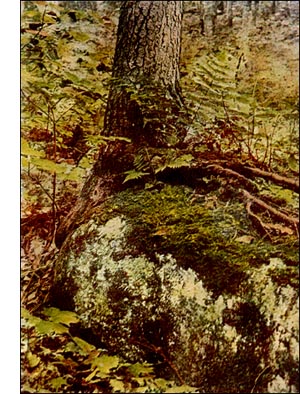Silvery Bryum Moss
 The Silvery Bryum, Bryum argenteum, Linn.
The Silvery Bryum, Bryum argenteum, Linn.Habit and habitat.-In green or silvery-white irregular cushions, on exposed ground, roofs, pavements, burnt places and almost everywhere except on trees. Very common.
Name.-The specific name refers to the colour. Latin argenteum, silvery. Johann Dillenius, a German botanist, called this moss "Catkin-stemmed Silver Moss" from its resemblance to the catkins of a poplar tree.
Plant (gametophyte).-Stems short, 1/2 to 1 inch high covered with root-like filaments; there are numerous shining catkin-like branches, each tipped with a brush of hairs.
Leaves.-At the apex of the stem, oblong-lance-shaped, taperpointed, silvery-gray; stem and branch leaves broadly oval, or inverted oval, deeply concave; apex abruptly pointed; margin entire, flat; vein (costa) vanishing above the middle; cells loose.
Habit of flowering.-Male and female on separate plants (dioicous). Male flowers terminal.
Veil (calyptra).-Narrowly hood-like, falling before the spore-case ripens.
Spore-case.-Abruptly pendulous, oblong, deep purple when ripe, constricted under the mouth when old.
Pedicel.-Long and curved at the summit, 1/2 inch high, dark red when mature.
Lid (operculum).-Convex, slightly pointed, dark-orange.
Teeth ( peristome).-As in the genus. Inner membrane yellow.
Annulus.-Present.
Spores.-Mature in fall and winter. Rarely fruiting in Great Britain.
Distribution.-Found in America, Europe and Asia. This is one of the five mosses which Sir Wm. Jackson Hooker found in the early part of the 19th Century at "Ultima Thule" of Antarctic vegetation.